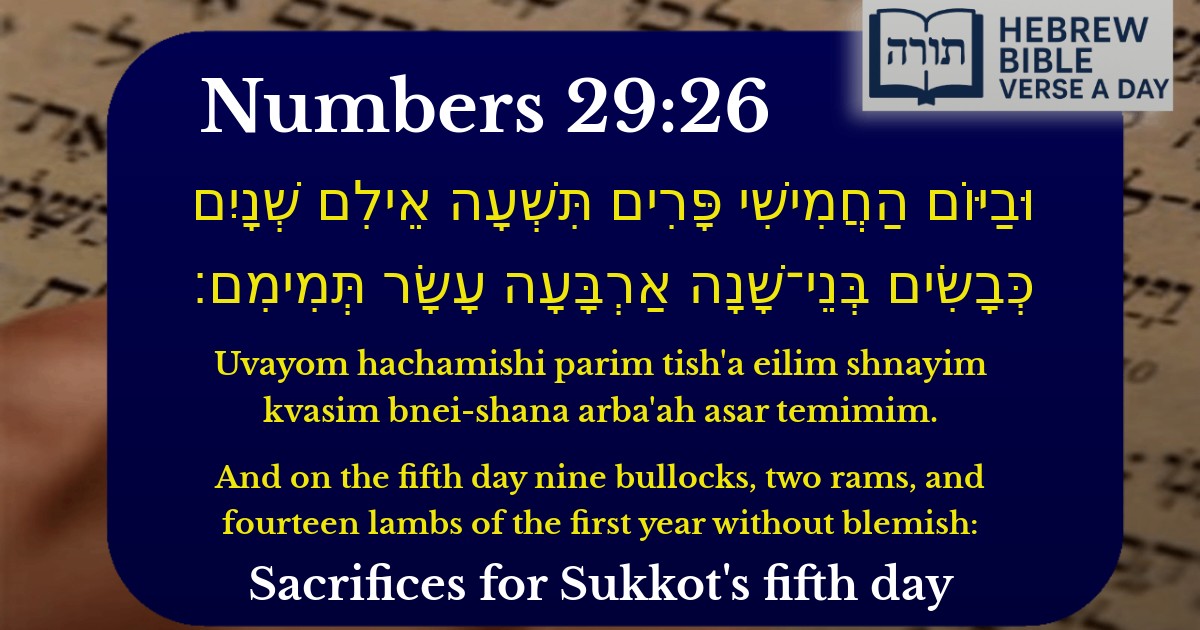Frequently Asked Questions
Q: What does Numbers 29:26 mean?
A: Numbers 29:26 describes the specific animal sacrifices brought on the fifth day of Sukkot (the Festival of Booths). According to the Torah, nine bulls, two rams, and fourteen unblemished lambs were offered as part of the holiday's additional offerings (Musaf). Rashi explains that these sacrifices were part of the communal worship in the Temple, demonstrating devotion to Hashem during this festive time.
Q: Why does the number of sacrifices change each day of Sukkot?
A: The number of bulls decreases each day of Sukkot (starting with 13 on the first day and reducing by one each day). The Talmud (Sukkah 55b) teaches that this symbolizes the gradual decrease of offerings, representing the Jewish people's spiritual refinement over the holiday. The consistent number of rams and lambs (two and fourteen, respectively) signifies unwavering commitment to Hashem.
Q: Why were the animals required to be 'without blemish' (תְּמִימִם)?
A: The Torah requires sacrifices to be physically perfect (תְּמִימִם) to symbolize that our service to Hashem must be wholehearted and without flaw. Rambam (Hilchos Issurei Mizbe'ach 3:1) explains that any defect in the animal would disqualify it, teaching us to offer only the best in our spiritual devotion.
Q: How is this verse relevant today without the Temple?
A: Although we no longer bring sacrifices, the verse teaches timeless lessons about dedication to Hashem. The Midrash (Vayikra Rabbah 27:11) states that prayer replaces sacrifices in exile. Just as the offerings were precise and wholehearted, our prayers should be offered with focus and sincerity, especially during Sukkot.
Q: What is the significance of the number of lambs (14) in this verse?
A: The fourteen lambs correspond to the seven days of Sukkot multiplied by the two daily Tamid offerings (morning and afternoon). The Talmud (Menachot 89b) connects this to the idea of continuous devotion—just as the Tamid was brought daily, Sukkot reinforces our constant connection to Hashem through festive observance.


Context in the Torah
The verse (Bamidbar 29:26) describes the offerings brought on the fifth day of Sukkot as part of the Musaf (additional) sacrifices. This follows the pattern of decreasing the number of bulls each day, starting from thirteen on the first day of Sukkot.
Rashi's Explanation
Rashi (Bamidbar 29:26) notes that the number of bulls decreases by one each day, totaling seventy bulls over the seven days of Sukkot. He explains that these seventy bulls correspond to the seventy nations of the world (based on Bereishit 10), symbolizing that the Jewish people bring sacrifices for the merit of all humanity.
Symbolism of the Numbers
Spiritual Significance
The Talmud (Sukkah 55b) teaches that the Sukkot offerings bring atonement for the nations, reflecting the universal role of the Jewish people as a "light unto the nations" (Yeshayahu 42:6). The decreasing bulls also hint at the eventual diminishment of negative influences in the world (Maharal, Gur Aryeh on Bamidbar 29:26).
Halachic Perspective
Rambam (Hilchot Temidin u'Musafin 9:1-2) details the precise order of these offerings, emphasizing that all must be temimim (unblemished), reflecting the need for sincerity and wholeness in divine service.